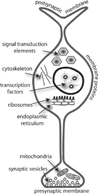Understanding the neurobiological consequences of early exposure to psychotropic drugs: linking behavior with molecules
- PMID: 15464125
- PMCID: PMC4204484
- DOI: 10.1016/j.neuropharm.2004.06.021
Understanding the neurobiological consequences of early exposure to psychotropic drugs: linking behavior with molecules
Abstract
Children receive significant exposure to psychotropic drugs. Some psychiatric disorders are diagnosed and treated in children as young as 2 years old, resulting in exposure to prescription stimulants, antidepressants, and mood stabilizers during brain development. Difficulties in diagnoses at such young ages increase the likelihood that children who are not affected by these disorders receive drug exposure inadvertently. Additionally, the increased availability of caffeine-containing beverages in schools has facilitated exposure to this stimulant in children. However, the consequences of exposure to psychotropic drugs during brain development are not understood. When we exposed rats to the prescription stimulant methylphenidate during early adolescence, we discovered long-lasting behavioral and molecular alterations that were consistent with dramatic changes in the function of brain reward systems. In future work, it will be important to determine if other classes of psychotropic drugs cause these same effects, and whether these effects will also occur if drug exposure begins during other periods of development. Moreover, it will be critical to use more powerful behavioral methods that are sensitive to high-level aspects of motivation and cognitive function, and to establish causal links between developmental exposure-related alterations in these complex behaviors and specific alterations in the molecular biology of key brain regions. This approach may identify classes of psychotropic drugs that have high or low propensities to cause behavioral and molecular adaptations that endure into adulthood. It may also identify periods of development during which administration of these agents is particularly safe or risky.
Figures




References
-
- Andersen SL, Rutstein M, Benzo JM, Hostetter JC, Teicher MH. Sex differences in dopamine receptor overproduction and elimination. Neuroreport. 1997;8:1495–1498. - PubMed
-
- Andersen SL, Arvanitogiannis A, Pliakas AM, LeBlanc C, Carlezon WA., Jr Altered responsiveness to cocaine in rats exposed to methylphenidate during early development. Nat. Neurosci. 2002;5:13–14. - PubMed
-
- Archakov AI, Govorun VM, Dubanov AV, Ivanov YD, Veselovsky AV, Lewi P, Janssen P. Protein-protein interactions as a target for drugs in proteomics. Proteomics. 2003;3:380–391. - PubMed
-
- Atkins JB, Chlan-Fourney J, Nye HE, Hiroi N, Carlezon, Nestler EJ. Region-specific induction of deltaFosB by repeated administration of typical versus atypical antipsychotic drugs. Synapse. 1999;33:118–128. - PubMed
-
- Bals-Kubik R, Herz A, Shippenberg TS. Evidence that the aversive effects of opioid antagonists and κ-agonists are centrally mediated. Psychopharmacology. 1993;98:203–206. - PubMed
Publication types
MeSH terms
Substances
Grants and funding
LinkOut - more resources
Full Text Sources

